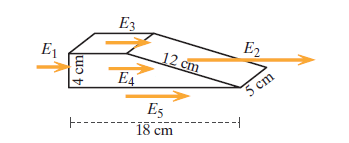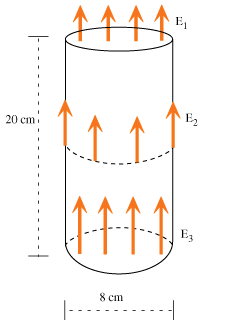Electric Fields
This page has been claimed by YongHui Cho
The Main Idea
Gauss' Law is the very first of Maxwell's Equations that dictates how Electric Field behaves around electric charges. By definition, Gauss' law is a quantitative relationship between measurements of electric field on a closed surface and the amount and sign of the charge inside that closed surface. In which, according to Gauss' Law for Electricity, the electric flux out of any closed surface is directly proportional to the total charge enclosed within the surface.
- To understand Gauss' law, understanding the concept of "flux" in context of Gauss' law is very important.
- Flux is the quantitative measure of the amount and direction of electric field over an entire surface.
- Flux has 3 properties:
- 1. Direction of Electric Field : In relation to the surface, if the electric field is directed outward from the surface the electric flux is positive. If the electric field is directed inward toward the surface the electric flux is negative. When in parallel with the surface, the electric flux is zero. Therefore, the electric flux is related to the angle the electric field makes with the surface.
- 2. Magnitude of Electric Field : The electric flux is directly proportional to Electric field and the angle [math]\displaystyle{ \cos \theta }[/math]. Therefore, the definition of electric flux contains the product of [math]\displaystyle{ E \cos \theta }[/math].
- 3. Surface Area: The electric flux is affected by the changing size of the surface. Taking account of the electric field on the surface, the surface area required to calculate flux.
- Now we can now define Electric Flux on a surface as
- [math]\displaystyle{ \Phi_el = \sum_{surface} \vec{E} \cdot \hat{n} \Delta A }[/math]
- [math]\displaystyle{ \vec{E} }[/math] represents the Electric Field, [math]\displaystyle{ \hat{n} }[/math] represents the direction, [math]\displaystyle{ \Delta A }[/math] represents the surface area.
- Now, back to the definition of Gauss' law - Gauss' law is a quantitative relationship between measurements of electric field on a close surface and the amount and sign of the charge inside that closed surface
- This simply means that Gauss' law is a sum of flux in a closed surface.
- Since
- [math]\displaystyle{ \text{electric flux on a surface} = \sum_{surface} \vec{E} \cdot \hat{n} \Delta A }[/math]
- it can also be written as
- [math]\displaystyle{ \text{electric flux on a surface} = \Phi_{el} = \int \vec{E} \cdot \hat{n} \Delta A }[/math]
- Then
- [math]\displaystyle{ \text{electric flux on a closed surface} = \oint \vec{E} \cdot \hat{n} \Delta A = \sum_{\text{closed surface}} \vec{E} \cdot \hat{n} \Delta A }[/math]
The quantitative relationship between measurements of electric field is stated, but the amount of charge inside the closed surface is not described.
- Recall that Coulomb's law is
- [math]\displaystyle{ E = {1\over 4\pi\varepsilon_0}{Q\over r^2} }[/math]
- Consider that we have a sphere with charges going outward. The sum of the total flux will be
- [math]\displaystyle{ \sum_{\text{closed surface}} \vec{E} \cdot \hat{n} \Delta A = {1\over 4\pi\varepsilon_0}{Q\over r^2}(+1)(4\pi r^2) = {Q\over \varepsilon_0} }[/math]
- having
- [math]\displaystyle{ \vec{E}={1\over 4\pi\varepsilon_0}, \hat{n} = (+1), \Delta A (4\pi r^2) \text{ (surface area of sphere)} }[/math]
Now in applying Gauss' law to the electric field of a point charge, The Gauss' law can be stated as
- [math]\displaystyle{ \sum_{\text{closed surface}} \vec{E} \cdot \hat{n} \Delta A = {\sum q_{inside} \over \varepsilon_0} }[/math]
- or
- [math]\displaystyle{ \oint \vec{E} \cdot \hat{n} \Delta A = {\sum q_{inside} \over \varepsilon_0} }[/math]
Why it matters
Gauss' law is a mathematical statement that total Electric Flux exiting any volume is equal to the total charge inside. Say there is a volume that has no charge within it. Then the net flow of Electric Flux out of it will be zero. If there are positive charges within the volume, then the net flow of Electric Flux will be a positive amount. On the other hand when the volume has negative charges, it will have a negative amount of Electric Flux which means Electric Flux enters the volume. This is an important observation for Gauss' Law is stating that electric charge acts as sources or sinks for Electric Fields. We can consider positive charges to be sources and negative charges to be sinks. This will give a lot of intuition about how the fields can physically act in any scenario (Coulomb's law does not consider moving charges!). Hence, Gauss' Law is a more formal statement of the force equation for electric charges.
History
According to Wikipedia, the theorem was first discovered by Lagrange in 1762, then later independently rediscovered by Gauss in 1813. However it was rediscovered by Ostrogradsky, who also gave the first proof of the general theorem, in 1826, and then by Green in 1828, etc. Subsequently, the variations on the divergence theorem are correctly called Ostrogradsky's theorem, but also commonly Gauss's theorem, or Green's theorem.
Practice Problems
The electric field has been measured to be horizontal and to the right everywhere on the closed box as shown in the figure below. All over the left side of the box [math]\displaystyle{ E_1 = 135 V/m }[/math], and all over the right (slanting) side of the box [math]\displaystyle{ E_2 = 396 V/m }[/math]. On the top the average field si [math]\displaystyle{ E_3 = 160 V/m }[/math], on the front and back the average field is [math]\displaystyle{ E_4 = 175 V/m }[/math], and on the bottom the average field is [math]\displaystyle{ E_5 = 200 V/m }[/math].
How much charge is inside the box? Explain briefly.
The electric field is measured all over the surfaces of a cylinder whose diameter is .08 m and whose height is .20 m, as shown in the diagram. At every location on the surface the electric field points in the same direction (+y). [math]\displaystyle{ E_1 }[/math] is found to be 558 V/m; [math]\displaystyle{ E_2 }[/math] is 744 V/m; [math]\displaystyle{ E_3 }[/math] is 1214 V/m.
- What is the net electric flux on this surface?
- How much charge is inside the surface?

